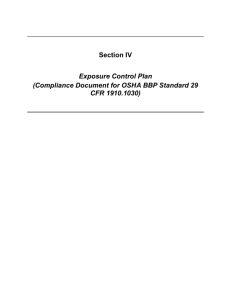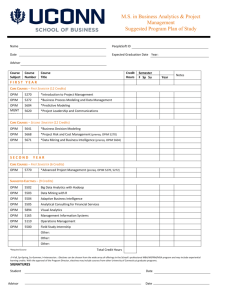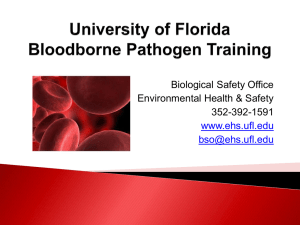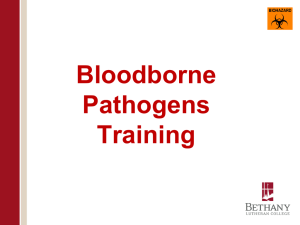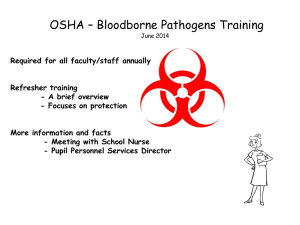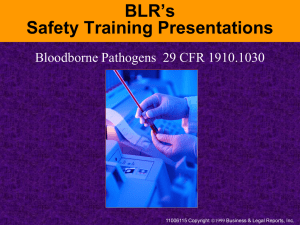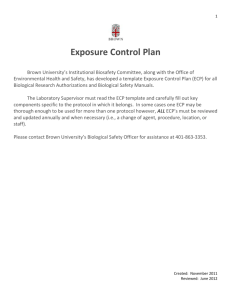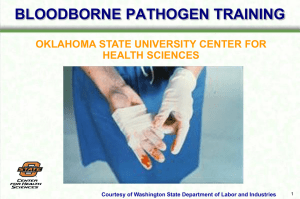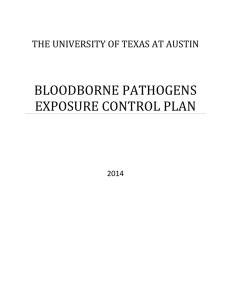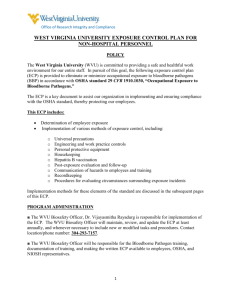Non-Research Exposure Control Plan (ECP)
advertisement
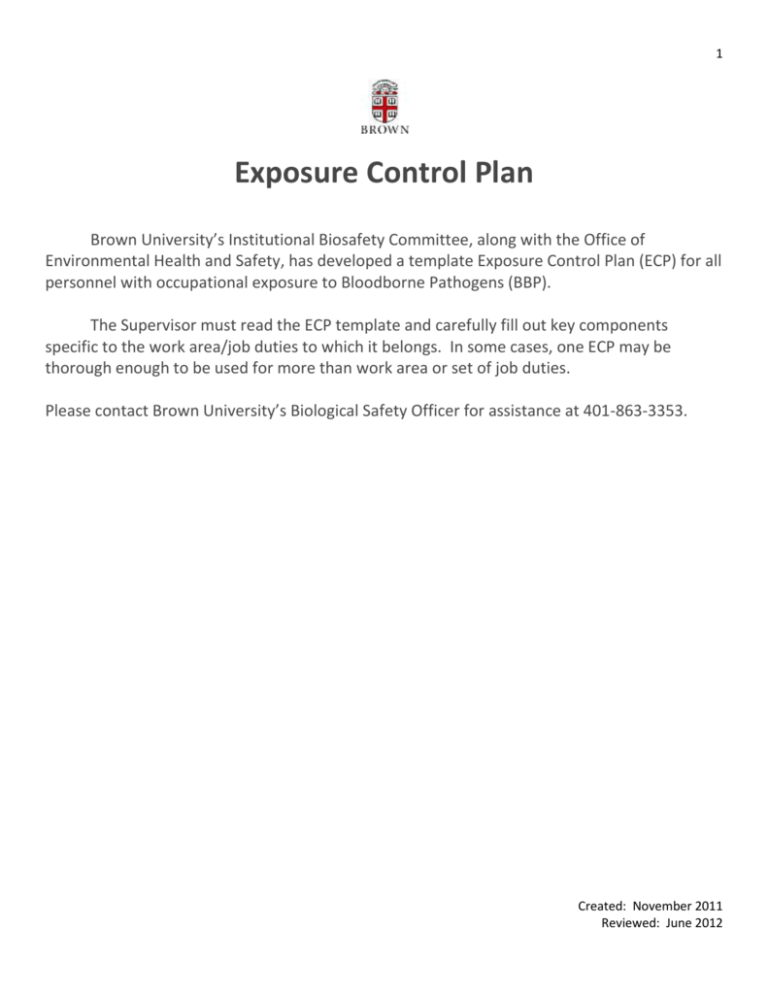
1 Exposure Control Plan Brown University’s Institutional Biosafety Committee, along with the Office of Environmental Health and Safety, has developed a template Exposure Control Plan (ECP) for all personnel with occupational exposure to Bloodborne Pathogens (BBP). The Supervisor must read the ECP template and carefully fill out key components specific to the work area/job duties to which it belongs. In some cases, one ECP may be thorough enough to be used for more than work area or set of job duties. Please contact Brown University’s Biological Safety Officer for assistance at 401-863-3353. Created: November 2011 Reviewed: June 2012 2 Exposure Control Plan (ECP) POLICY Brown University is committed to providing a safe and healthful work environment for faculty, students, and staff. In pursuit of this goal, the following Exposure Control Plan (ECP) is provided to assist staff in developing procedures to eliminate or minimize occupational exposure to bloodborne pathogens and Other Potentially Infectious Material (OPIM) in accordance with the Institutional Biosafety Committee (IBC) and OSHA standards. This ECP includes: Determination of employee exposure Implementation of various methods of exposure control, including: Universal precautions Engineering and administrative controls Personal protective equipment Hepatitis B vaccination Disinfection/sterilization Housekeeping Post-exposure evaluation and follow-up Recordkeeping Communication of hazards to visitors/contractors Training Implementation methods for these elements of the standard are discussed in the subsequent pages of this ECP. PROGRAM ADMINISTRATION The supervisor (listed below) is responsible for implementation of the ECP in location(s) covered by the plan, will maintain, review and update the ECP at least annually, and whenever necessary to include new or modified tasks and procedures. Supervisor Name: Work areas covered by this ECP (Bldg and Room #): Job duties covered by this ECP: Contact Number (include area code): 24-Hour Contact Number (mobile/home): Created: November 2011 Reviewed: June 2012 3 PERSONNEL EXPOSURE DETERMINATION The following is a list of all personnel who perform tasks and procedures in which occupational exposure may occur and who must comply with all provisions outlined in this Exposure Control Plan (ECP). Name/Job Title (example: John Smith, EMT) Work Area Location (Building and room number) Task/Procedure (example: Assisting with injured Brown Faculty, staff, students) METHODS OF IMPLEMENTATION AND CONTROL Universal Precautions Universal Precautions is an approach to infection control. According to the concept of Universal Precautions, all human blood and human body fluids are treated as if known to be infectious for HIV, HBV, and other Bloodborne Pathogens, even though they may not be. Exposure Control Plan Training Created: November 2011 Reviewed: June 2012 4 In addition to completion of Brown University EHS Bloodborne Pathogen (BBP) Training, personnel with occupational exposure to Bloodborne Pathogens (BBP) or Other Potentially Infectious Material (OPIM) shall read and understand the specific ECP for the work area/job duties to which they are assigned. Engineering Controls and Administrative Controls Engineering controls and administrative controls will be used to prevent or minimize exposure to BBP and OPIM. Whenever possible, select and utilize engineering controls and administrative controls that mitigate exposure such as, but not limited to: Tongs Squeegees Puncture-proof containers for sharps Personal protective equipment (PPE) Administrative controls are defined as: controlling workplace hazards through methods such as training, written operating procedures, work permits, safe work practices, exposure time limitations, alarms, signs, and warnings. The specific engineering controls and administrative controls used for this work area/these job duties are listed below: Engineering Controls Administrative Controls Created: November 2011 Reviewed: June 2012 5 Broken glass or sharps involved in a blood or OPIM spill clean-up should be carefully collected with tongs and placed in a puncture-proof container such as a “sharps container” or a five gallon bucket. Sharps must fit completely into the selected sharps container (i.e., not to exceed the manufacturers marked "full" line or in the case of a bucket, the plane of entry). Do not force or push any item into a sharps container. When the container is full, it must be closed and EHS must be contacted at 401-863-3353 so that the container may be collected. For EMT’s and Health Services personnel: Sharps containers shall be replaced before they become overfilled to prevent needle sticks. Do not bend, break, re-cap, or re-sheath any needle. Requests for full sharp container pick-up and replacement containers supplied by EHS can be made through the Container Request form located at the following URL: http://brown.edu/Administration/EHS/container_disposal/ Personal Protective Equipment (PPE) Describe below, the appropriate PPE that will be used for specific tasks or procedures. (Examples: Double Nitrile gloves, splash goggles, an N95, and a Tyvek suit when necessary, will be worn while performing blood or OPIM spill clean-up.) PPE Task/Procedure All personnel using PPE must use these precautions: If the spill is very large or the contamination is not easy to reach without contaminating yourself, please contact public safety 401-863-4111 so that the EHS Emergency Response Team may assist. Carefully approach the spill so as not to spread contamination Don PPE BEFORE engaging in blood or OPIM spill clean-up Created: November 2011 Reviewed: June 2012 6 Wear appropriate gloves when it is reasonably anticipated that there may be hand contact with blood or OPIM, and when handling or touching contaminated items or surfaces; replace gloves if torn, punctured or contaminated, or if their ability to function as a barrier is compromised Double glove (Disposable gloves) Change gloves often Wear appropriate face and eye protection when splashes, sprays, spatters, or droplets of blood or OPIM pose a hazard to the eye, nose, or mouth Apply absorbent to the spill area BEFORE spraying decontaminant Contact time is important—allow 15 minutes for the decontaminant to soak before wiping up Do not touch and contaminate items you plan to re-use with contaminated gloves Remove PPE after it becomes contaminated and before leaving the work area Remove gloves carefully to avoid spraying or spatter Wash hands immediately or as soon as feasible after removing gloves or other PPE. Never wash or decontaminate disposable gloves for reuse. Remove immediately or as soon as feasible any garment contaminated by blood or OPIM, in such a way as to avoid skin/mucous membrane or eye contact with the outer surface Small amounts of blood or OPIM on your uniform may be laundered out through the University’s laundering service Large amounts of blood or OPIM on your uniform will result in your uniform being discarded If utility gloves are being used over nitrile or rubber gloves as cut protection, dispose if contaminated Vaccination/Screening Program (Hepatitis B) Any employee with occupational exposure to Bloodborne Pathogens (BBP) is eligible to receive the Hepatitis B vaccination series covered by their employer. Will the employees working in the area subject to this Exposure Control Plan be informed of this policy by their supervisor? ___ No. ___ Yes. Disinfection and Sterilization In cleaning up suspect BBP spills, it is important to properly disinfect. In order to kill the infectious microbial life in the spill, a chemical disinfectant should be used for an appropriate amount of time. Absorbent towels should be placed over the entire spill area and then disinfectant -- either Triad (custodial/health services staff/DPS) or BleachRite (dining services/athletics) should be carefully sprayed on the absorbent towels until saturated. The disinfectant chemical should be allowed to sit on the spill area for 15 minutes before it is wiped up. 15 minutes is enough contact time to ensure the chemical kill the infectious microbial life. Housekeeping Created: November 2011 Reviewed: June 2012 7 An organized, clean, stocked key station/work area is imperative for safety. A proper inventory of Blood/OPIM spill-kits must be maintained. Below, is an inventory of a typical Blood/OPIM spill kit. Items Number in Kit Disposable Nitrile gloves Splash goggles Surgical mask Disposable booties Absorbent Triad/Bleachrite (disinfection agent) Tongs Squeegee Dustpan Red biohazard bag 5 gallon bucket Laundry Uniforms exposed to blood or OPIM during a clean-up should never be brought home for laundering. Uniforms exposed to small amounts of blood or OPIM should be laundered by the University’s laundering service. Uniforms exposed to large amounts of blood or OPIM should be discarded and replaced. List the types of items specific to this work area or job duties that may require laundering or replacement when contaminated: Example: Uniform, replaced after contamination) Item Replacement/Laundering Frequency In addition, the following general laundering requirements must be met: Wear appropriate PPE when handling and/or sorting laundry Created: November 2011 Reviewed: June 2012 8 Handle potentially contaminated laundry as little as possible, with minimal agitation Place wet laundry in leak-proof and appropriately labeled containers before transport Labels and Door Signs Any equipment or container contaminated with bloodborne pathogens or OPIM must display the universal biohazard symbol i.e., biological sharps containers, vacuum flasks etc. This symbol must also appear on any door where biological waste is held. Contact EHS at 401-863-3353 for changes to be made to the door sign. POST-EXPOSURE EVALUATION AND FOLLOW-UP There are several types of Emergency Exposures to blood or OPIM that could lead to injury or illness in faculty, staff and students: Parenteral-puncture from a sharp, animal bites Mucous Membrane- contact through eyes, nose, mouth, inhalation Non-intact Skin-cut/scrape, rash, cold sore, acne, hang nail Should an Emergency Exposure incident occur: • • • • Immediately wash area with soap and water, or in case of an eye exposure flush with copious amounts of water Use an emergency eyewash if available Notify your supervisor who will notify Environmental Health and Safety and Insurance and Risk Contact Brown University Public Safety at 401-863-4111 Created: November 2011 Reviewed: June 2012 9 • Seek first aid/medical treatment and always consult with a physician i.e. health services, a doctor etc. For proper reporting use the forms found here: http://www.brown.edu/Administration/EHS/lab/PDFs/accident_form.pdf http://www.brown.edu/Administration/Office_of_Insurance_and_Risk/documents/Injury%20AR%20Form%20Rev.6%27 06.doc.pdf Any exposure to blood or OPIM should be reported, but sometimes this is not considered an emergency. For example when blood or OPIM comes in contact with in-tact skin. If you are exposed to blood or OPIM in a non-emergency situation: • • • • Immediately wash area with soap and water Notify your supervisor Your supervisor should notify Environmental Health and Safety and Insurance and Risk Seek first aid/medical treatment and always consult with a physician i.e. health services, a doctor etc. For proper reporting use the forms found here: http://www.brown.edu/Administration/Office_of_Insurance_and_Risk/documents/Injury%20AR%20Form%20Rev.6%27 06.doc.pdf PERSONNEL TRAINING All employees who have reasonably anticipated occupational exposure to bloodborne pathogens, or OPIM, shall receive task-specific training conducted by the supervisor or designee. The supervisor shall also ensure that task-specific training is appropriately documented. Provide below tasks/procedures for which personnel will receive task-specific training: (Example: blood/OPIM spill cleanup kit disposal) Created: November 2011 Reviewed: June 2012 10 RECORDKEEPING Training Records Training for task-specific/ training shall be documented. These documents will be kept (Insert location of records here___________) for the duration of employment. The training records include: Dates of the training sessions Contents or a summary of the training sessions Names and qualifications of persons conducting the training Names and job titles of all persons attending the training sessions Communication of Hazards Informing Other Employers/Contractors It is the responsibility of the Supervisor to provide other employees and contractors with information about hazardous chemicals, bloodborne pathogens, and OPIM that employees may be exposed to on a job site along with suggested precautions and PPE. In all events contractors or employees should use Universal Precaution while working at Brown University. There are several resources available to assist Supervisors and Departments with tasks related to blood/OPIM spill clean-up. Contact the Office of Environmental Health & Safety at 863-3353 for more information. Created: November 2011 Reviewed: June 2012

